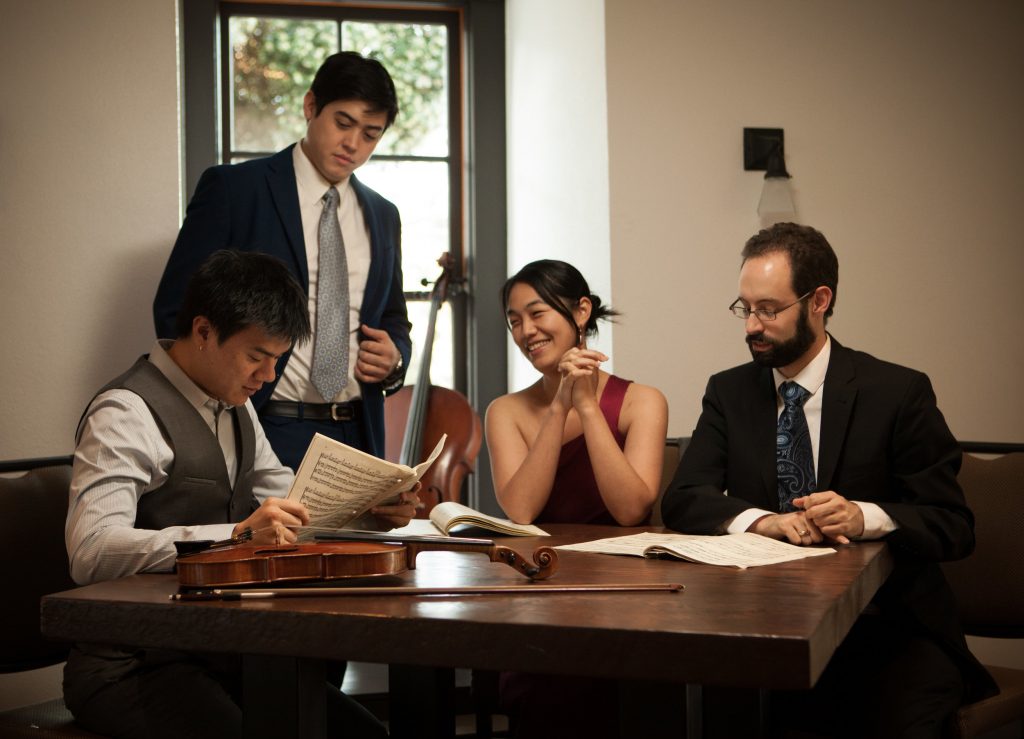The lines hum in Telegraph Quartet’s crackling Chamber Music Houston set

Chamber Music Houston devotes one slot in each season’s series to an emerging ensemble, and San Francisco-based Telegraph Quartet showed powerful qualities as this year’s pick Tuesday at Rice University’s Stude Concert Hall. Winner of the 2016 Naumburg Chamber Music Award and quartet-in-residence at the San Francisco Conservatory, the quartet boasted the eagerness and vitality of youth, and an expressiveness and dramatic flair that should help nourish the group as it matures.
Violinists Eric Chin and Joseph Maile, who traded places between first and second chairs, helped set the tone with their vigor and vividness. Violist Pei-Ling Lin and cellist Jeremiah Shaw added their own color and impact, stepping forth dramatically when the music called for it. Tuesday’s concert was also a homecoming of sorts for Maile and Lin, who hold degrees from Rice’s Shepherd School of Music.
Whether or not this happened by design — Maile didn’t mention it in his remarks — all three works came from composers less than 30 years old. If the players identified with that, they captured it above all in the sheer exuberance they brought to Felix Mendelssohn’s Quartet in D major.
Chin, playing first violin, led the way with dash and precision galore in the first movement and finale, and the rest of the group matched him all the way with crackling background and whirlwind banter.
In the first movement, they moved from the opening’s gleam to a more muted, pensive theme. When that minor-tinged melody finally turned more optimistic, the group handled the metamorphosis deftly.
The players were just as adroit with the quartet’s more intimate middle movements. The lyrical menuet unfolded so smoothly, and with such a gentle lilt, that it sang as much as it danced. The pulsing motion underlying the Andante lent it a tinge of restlessness, and as its tension rose, the group bore down enough to bring out the change — but without breaking the overall introspectiveness.
And when excitement returned in the finale, the players conjured up its sunshine with tone that glistened even more brilliantly than in the quartet’s opening. And they occasionally slipped in a suave turn of phrase to balance the exuberance with elegance.
The group sandwiched the ever-popular Mendelssohn between two composers whose music has only gained prominence relatively recently, and is still on the rise.
Erwin Schulhoff composed his Five Pieces for String Quartet in 1923, long before his imprisonment and death in a Nazi concentration camp. The Czech crafted five wry takes on then-popular forms, and the players savored the music’s reinterpreted flavors.
“Viennese” plays rhythmic tricks that keep a waltz off-kilter, and Telegraph’s swooping glissandos played up the melody’s gusto. The quirky, not-very-lyrical “Serenade” ended in spooky pianissimo, and the group gave “Czech Folk Music” a fire and abandon worthy of Bartok. The group’s rhythmic prowess animated “Tango” — which is capped off with an out-of-the-blue crunch of dissonance — and ended the suite with a burst of bold attacks and driving rhythm in “Tarantella.”
Mieczysław Weinberg, who escaped the Nazis by fleeing to Russia, composed his Quartet No. 6 in the late 1940s, so its brooding and explosiveness inevitably sound today like responses to World War II’s upheaval. Though Weinberg’s quartet has kinships to the music of his friend Dmitri Shostakovich, it speaks with a voice of its own.
The six movements encompass more than a half-hour of introspection and agitation. They progress from a lyrical opening through two explosive fast movements to a spacious, fugal Adagio at the quartet’s heart. The fifth movement has a furtive, uneasy aura, and even though the finale closes with a major chord, the music doesn’t really sound like it has achieved resolution.
Violinist Maile took over the first chair, and he particularly seized on the cadenza-like third movement, switching handily from its initial ferocity to the hush that paves the way for the Adagio’s fugue. Maile’s intonation wavered during some of the fugue’s high, exposed moments, but he and his fellow players by and large brought Weinberg’s music drama, intensity and a vivid palette.
The group gave poise and person-to-person immediacy to the first movement’s lyricism, and it captured the second movement’s explosiveness as readily as the fugue’s prevailing stillness. When agitation took hold, violist Lin and cellist Shaw added some especially compelling outbursts.
As the final movements turned at times toward restlessness and hints of peace, the deft touches that were so telling in their Mendlessohn resurfaced here. The group added a valuable perspective on a composer whom audiences are still discovering.
Chamber Music Houston presents the Vienna Piano Trio at 7:30 p.m. Feb. 27 in Rice University’s Stude Concert Hall. chambermusichouston.org; 713-348-5400.


